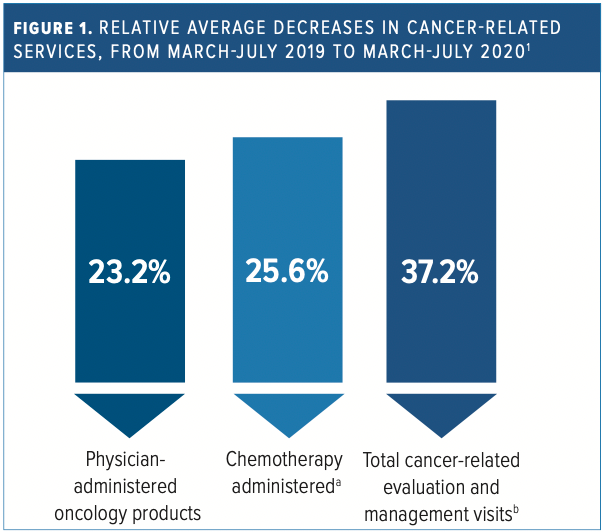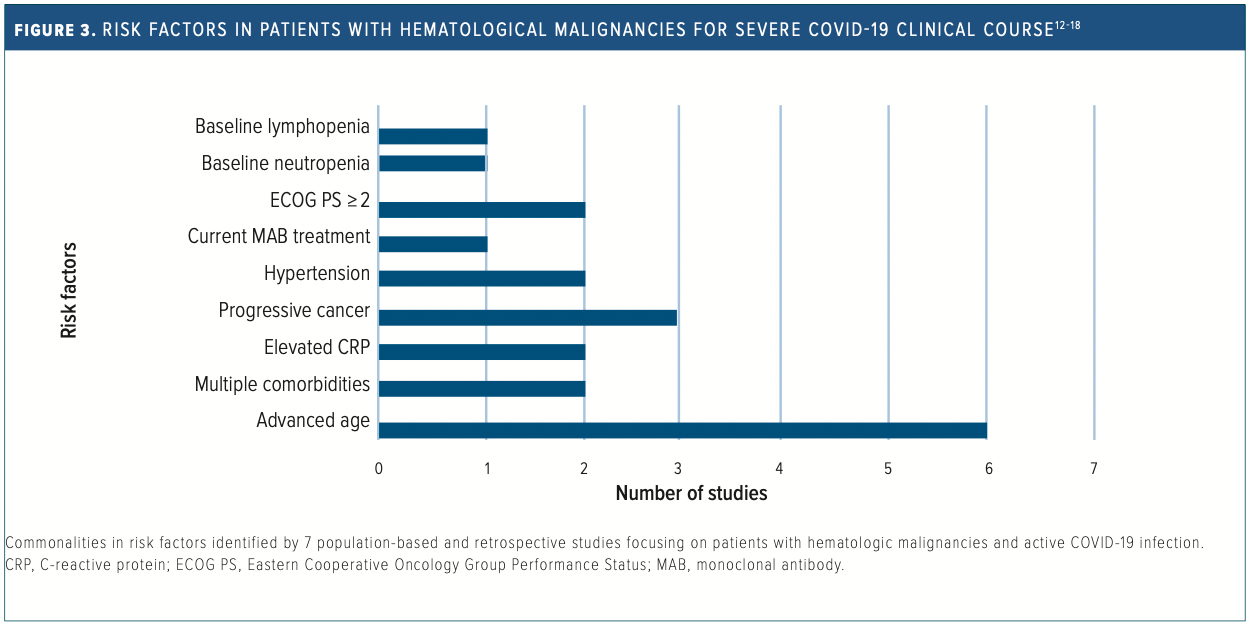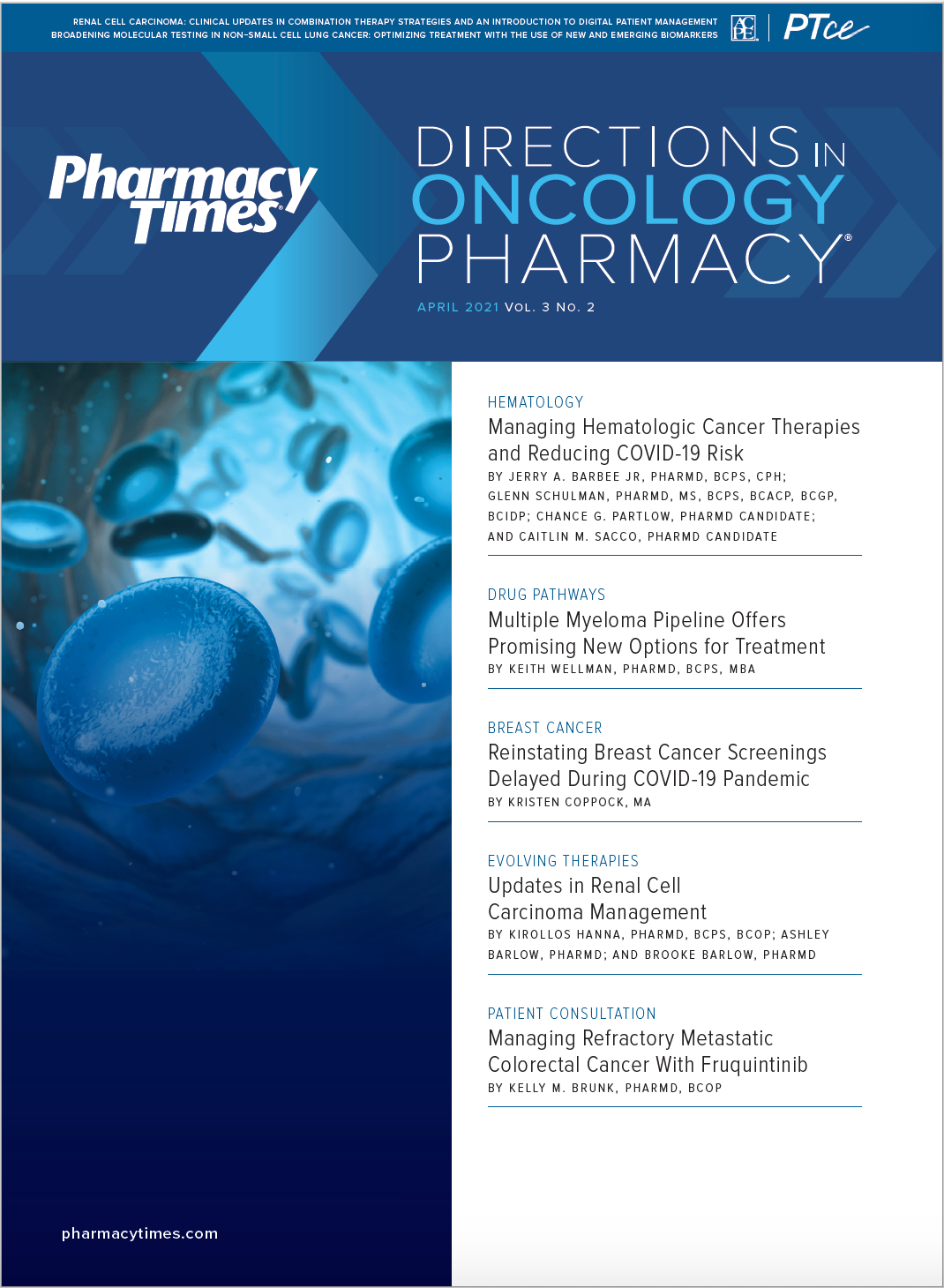Publication
Article
Pharmacy Practice in Focus: Oncology
Managing Hematologic Cancer Therapies and Reducing COVID-19 Risk
Author(s):
In this high-risk population, strategies for minimizing viral exposure during a pandemic are being considered with oncology treatment options.
Since the onset of COVID-19 cases in January 2020 and the subsequent pandemic, health care has become less accessible, according to the CDC.1 Patients with chronic diseases are reluctant to attend routine appointments and screenings due to concern about COVID-19.1 As a result, screenings, oncology visits, and treatments decreased significantly during the months of March to July 2020 vs the comparable time period in 2019 (Figure 1).1 Enhanced emphasis has been placed on telemedicine or virtual visits to provide follow-up care in this patient population.1

Mortality Risk Factors
Patients’ reluctance to seek care is not unfounded. Those with malignancies are at greater risk of dismal outcomes from infection because of their poor overall health and receiving immunomodulating therapy.2,3
Hematologic malignancies consist of at least 30 tumor types, differing by lineage (ie, myeloid vs lymphoid), genetic alterations, and pathogenesis.4 Lymphomas, multiple myeloma, and most types of leukemia initially affect blood cells used in the immune response.4
In contrast to patients with solid tumor cancers, patients with specific hematologic malignancies are confronted with multimodal immunosuppression from their disease and associated treatment.4 Retrospective analyses have suggested 2-fold greater mortality rates in patients who are COVID-19 positive with hematologic malignancies vs those with solid tumors.2,3
According to data from the American Society of Hematology (ASH) Research Collaborative COVID-19 Registry for Hematology, denial of intensive care unit (ICU) care, poor pre–COVID-19 prognosis, and more advanced malignancies were also associated with a higher mortality risk (Figure 2).5
Findings from retrospective studies examining this population found higher rates of severe disease as a result of COVID-19 in comparison with patients without cancer, but no significant difference in incidence rates of contracting the virus.6
According to a study in the United Kingdom, patients with hematologic malignancies were 57% more likely to experience a severe case of COVID-19 than those with other types of cancer.7 In addition, patients with hematologic malignancies demonstrated prolonged viral shedding (up to a median of 32.7 days) compared with nononcology patients, which affects time for postinfection isolation and time to cancer treatment reinitiation.6

Cancer and COVID-19, a Recipe for VTE?
Considering that 20% of venous thromboembolisms (VTEs) occur as a result of cancer, the endothelial injury, immobility, and amplified circulation of prothrombotic factors that are present during an acute COVID-19 infection create a potentially lethal combination.8,9
Certain hematologic malignancies are associated with an especially high incidence of VTE. This is particularly concerning because many patients with blood cancers are older and have comorbidities that predispose them to the thrombotic sequela of COVID-19.10 For example, 10% of patients with aggressive lymphomas and 6% with multiple myelomas (MMs) experience VTEs.11
Seven retrospective and population-based studies examined outcomes and risk factors due to COVID-19 in patients with hematologic malignancies. The findings demonstrated little consistency among them (Figure 3).12-18
The risk factors identified by investigators of these studies are likely less specific to the cancer itself and more indicative of the patient’s overall health status and advanced age.

Patient Treatment
During the pandemic, consensus recommendations regarding the treatment of patients with hematological malignancies are focused on strict exposure prevention and the reduction of risk factors; acute treatment is the same as that for the general population.6,19 This includes strict adherence to social distancing recommendations by the CDC and World Health Organization (WHO) and rigorous COVID-19 screening prior to chemotherapy or procedures.
The use of telemedicine has increased, which balances the potential harm of treatment delay with the risk of disease transmission.20 For example, treatment should not be deferred for cancers that are curable and associated with inferior outcomes when treatment is delayed, such as pediatric acute lymphoblastic leukemia.19
Based on a summary of current recommendations, standard treatment for cancer should resume in the absence of active infection with COVID-19, whereas treatment decisions during an active infection should be decided on a case-by-case basis.6,19 As long as efficacy is not compromised, oral chemotherapy and regimens that minimize infusions are preferred in order to limit exposure of transmission; some experts have switched to oral management exclusively in chronic and small lymphoma leukemia, mantle cell lymphoma, and marginal zone lymphoma.19,21 Similarly, prompt and prophylactic management of treatment-related adverse events should be provided for patients on chronic, oral chemotherapy to prevent unnecessary hospitalization and subsequent exposure.6
Convalescent Plasma—a Role in Therapy?
A retrospective analysis of patients with a current or past hematologic malignancy from the CCC19 study (NCT04354701) demonstrated a potential benefit of patients receiving convalescent plasma treatment (CPT). Of the 966 patients included, 143 (15%) received CPT.
After adjusting for confounders, 30-day mortality was significantly lower in the CPT cohort from the propensity score-matching analysis (HR, 0.52 [0.29-0.92]). Within this subset of patients, investigators also saw benefit in the 338 patients who were admitted to the ICU (propensity score–matched HR, 0.4 [0.20-0.80]) and in the 227 mechanically ventilated patients (propensity score–matched HR, 0.32 [0.14-0.72]).22 It is worth noting that along with other inherent limitations commonly associated with observational trials, patients were inequitably treated in the interest of expediency with other experimental COVID-19 treatments, such as corticosteroids, hydroxychloroquine, remdesivir, and tocilizumab, even after propensity score matching. Albeit controversial, CPT may play a role in the treatment of patients co-afflicted with COVID-19 plus hematological malignancies and associated B-cell lymphopenia to help restore neutralizing antibodies; however, clinicians must await the results of randomized clinical trials, which remain the gold standard of efficacy.
Beat AML—an Adaptive Approach
The Leukemia and Lymphoma Society (LLS) recently launched a substudy (LLS protocol number: BAML-16-001-COV1) as part of its master protocol Beat AML Trial (NCT03013998). The study examines the use of acalabrutinib, a Bruton tyrosine kinase inhibitor, in patients with acute myeloid leukemia, acute lymphoblastic leukemia, aplastic anemia, and myelodysplastic syndromes who are COVID-19 positive.
The theoretical benefit is attributed to acalabrutinib’s ability to diminish the uncontrolled inflammatory response elicited by COVID-19 that often leads to organ failure.10 As we await the results of BAML-16-001-COV1, perhaps the most exciting aspect of Beat AML’s expanding to include COVID-19 patients is that the study’s master protocol design allows for the seamless incorporation of novel treatments as the trial progresses.
Conclusion
With innovations in medication therapy, patient treatment, and video teleconferencing, there is room for cautious optimism regarding patients with hematologic malignancies. Strategies proposed in an attempt to minimize COVID-19-related mortalities in these patients need to be adapted as we navigate through this pandemic. This group will always be at greater risk, with less auspicious outcomes due to their underlying comorbidities and inherent increased propensity for thromboembolic events.
With 3 highly effective COVID-19 vaccines available, improved screening and treatment strategies, and earlier testing, this vulnerable patient population will be able to accrue enhanced outcomes as the pandemic assumes a more favorable trajectory.
REFERENCES
- Patt D, Gordan L, Diaz M, et al. Impact of COVID-19 on cancer care: how the pandemic is delaying cancer diagnosis and treatment for American seniors. JCO Clin Cancer Inform. 2020;4:1059-1071. doi:10.1200/CCI.20.00134
- Meng Y, Lu W, Guo E, et al. Cancer history is an independent risk factor for mortality in hospitalized COVID-19 patients: a propensity score-matched analysis. J Hematol Oncol. 2020;13(1):75. doi:10.1186/s13045-020-00907-0
- Mehta V, Goel S, Kabarriti R, et al. Case fatality rate of cancer patients with COVID-19 in a New York hospital system. Cancer Discov. 2020;10(7):935-941. doi:10.1158/2159-8290. CD-20-0516
- Moasser MM, Ai WZ. Neoplasia. In: Hammer GD, McPhee SJ, eds. Pathophysiology of Disease: An Introduction to Clinical Medicine. 8th ed. McGraw-Hill Education; 2019: 89-140.
- Susman E. Blood cancers and COVID-19: ‘a medically vulnerable’ group. MedPage Today. December 6, 2020. Accessed March 6, 2021. https://www.medpagetoday.com/meetingcoverage/ ashhematology/90045?vpass=1
- Hus I, Salomon-Perzyński A, Tomasiewicz K, Robak T. The management of hematologic malignancies during the COVID-19 pandemic. Expert Opin Pharmacother. Published online December 21, 2020. doi:10.1080/14656566.2020.1849143
- Lee LYW, Cazier JB, Starkey T, et al; UK Coronavirus Cancer Monitoring Project Team. COVID-19 prevalence and mortality in patients with cancer and the effect of primary tumour subtype and patient demographics: a prospective cohort study. Lancet Oncol. 2020;21(10): 1309-1316. doi:10.1016/S1470-2045(20)30442-3
- Fernandes CJ, Morinaga LTK, Alves Jr JL, et al. Cancer-associated thrombosis: the when, how and why. Eur Respir Rev. 2019;28(151):180119. doi:10.1183/16000617.0119-2018
- Singhania N, Bansal S, Nimmatoori DP, Ejaz AA, McCullough PA, Singhania G. Current overview on hypercoagulability in COVID-19. Am J Cardiovasc Drugs. 2020;20(5):393-403. doi:10.1007/s40256-020-00431-z
- Trial to test acalabrutinib for patients with blood cancer, COVID-19. Healio. October 7, 2020. Accessed March 6, 2021. https://www.healio.com/news/hematology-oncology/20201007/ trial-to-test-acalabrutinib-for-patients-with-blood-cancer-covid19
- Kekre N, Connors JM. Venous thromboembolism incidence in hematologic malignancies. Blood Rev. 2019;33:24-32. doi:10.1016/j.blre.2018.06.002
- Aries JA, Davies JK, Auer RL, et al. Clinical outcome of coronavirus disease 2019 in haemato-oncology patients. Br J Haematol. 2020;190(2):e64-e67. doi:10.1111/bjh.16852
- García-Suárez J, de la Cruz J, Cedillo Á, et al; Associación Madrileña de Hematología y Hemoterapia (AMHH). Impact of hematologic malignancy and type of cancer therapy on COVID-19 severity and mortality: lessons from a large population-based registry study. J Hematol Oncol. 2020;13(1):133. doi:10.1186/s13045-020-00970-7
- Infante MS, González-Gascón Y Marín I, Muñoz-Novas C, et al. COVID-19 in patients with hematological malignancies: a retrospective case series. Int J Lab Hematol. 2020;42(6):e256-e259. doi:10.1111/ijlh.13301
- Martín-Moro F, Marquet J, Piris M, et al. Survival study of hospitalised patients with concurrent COVID-19 and haematological malignancies. Br J Haematol. 2020;190(1):e16-e20. doi:10.1111/bjh.1680
- Passamonti F, Cattaneo C, Arcaini L, et al; ITA-HEMA-COV Investigators. Clinical characteristics and risk factors associated with COVID-19 severity in patients with haematological malignancies in Italy: a retrospective, multicentre, cohort study. Lancet Haematol. 2020;7(10):e737-e745. doi:10.1016/S2352-3026(20)30251-9
- Piñana JL, Martino R, García-García I, et al; Infectious Complications Subcommittee of the Spanish Hematopoietic Stem Cell Transplantation and Cell Therapy Group (GETH). Risk factors and outcome of COVID-19 in patients with hematological malignancies. Exp Hematol Oncol. 2020;9:21. doi:10.1186/s40164-020-00177-z
- Sanchez-Pina JM, Rodríguez Rodriguez M, Castro Quismondo N, et al. Clinical course and risk factors for mortality from COVID-19 in patients with haematological malignancies. Eur J Haematol. 2020;105(5):597-607. doi:10.1111/ejh.13493
- Coronavirus Disease 2019 (COVID-19) Treatment Guidelines. National Institutes of Health. Updated March 5, 2021. Accessed March 7, 2021. https://www.covid19treatmentguidelines.nih.gov/
- Framework for healthcare systems providing non-COVID-19 clinical care during the COVID-19 pandemic. CDC. Updated June 30, 2020. Accessed March 7, 2021. https://www.cdc. gov/coronavirus/2019-ncov/hcp/framework-non-COVID-care.html
- Ranjana R, Bartlett N, LaCasce A, et al. COVID-19 and indolent lymphomas: frequently asked questions. American Society of Hematology. Updated February 5, 2021. Accessed March 8, 2021. https://www.hematology.org/covid-19/ covid-19-and-indolent-lymphomas
- Thompson MA, Henderson JP, Shah PK, et al. Convalescent plasma and improved survival in patients with hematologic malignancies and COVID-19. medRxiv. February 5, 2021. Accessed March 6, 2021. https://www.medrxiv.org/content/10.1101/2021.02.05.21250953v1







